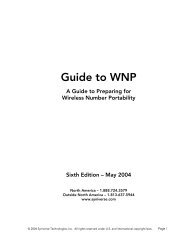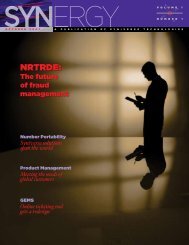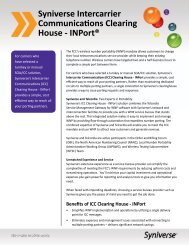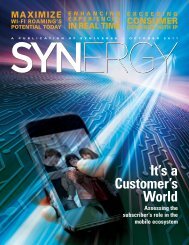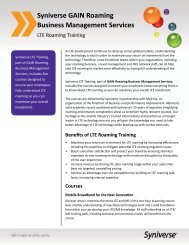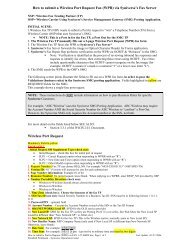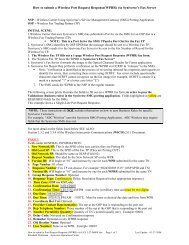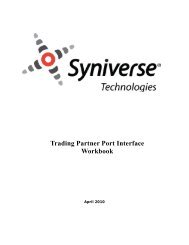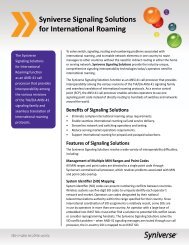messaging in africa mms explosion financial clearing upgrades
messaging in africa mms explosion financial clearing upgrades
messaging in africa mms explosion financial clearing upgrades
- No tags were found...
Create successful ePaper yourself
Turn your PDF publications into a flip-book with our unique Google optimized e-Paper software.
10REVOLUTION Cont. from pg. 7Jeff GordonChief Technology Officer“Almost any operatorcan look to thrive <strong>in</strong>this dynamic environmentby establish<strong>in</strong>gan <strong>in</strong>dispensable roleas the ecosystem’s‘smart pipe’ ”Challenge 1: Ma<strong>in</strong>ta<strong>in</strong><strong>in</strong>g relevancy <strong>in</strong> the ecosystemNew players are enter<strong>in</strong>g the mobile ecosystem on a daily basis, <strong>in</strong>clud<strong>in</strong>g cable MSOs, M2M, Internetand VoIP providers as well as thousands of over-the-top application developers. And just as operators are,they’re all focused on achiev<strong>in</strong>g end-user <strong>in</strong>teraction and tapp<strong>in</strong>g <strong>in</strong>to the revenue streams that have beencreated by the mobile revolution.Fortunately, almost any operator can look to thrive <strong>in</strong> this dynamic environment by establish<strong>in</strong>g an<strong>in</strong>dispensable role as the ecosystem’s “smart pipe,” deliver<strong>in</strong>g value to its subscribers, other operators andnew mobile players.The road to “smart pipe” status requires an operator to become an ecosystem partner rather thanstand<strong>in</strong>g alone. This means work<strong>in</strong>g with these new entrants and th<strong>in</strong>k<strong>in</strong>g about how an operator can addvalue to the relationship.By sitt<strong>in</strong>g <strong>in</strong> the middle of the <strong>in</strong>dustry’s tremendously complex communication structure and hav<strong>in</strong>gthe proper bus<strong>in</strong>ess <strong>in</strong>telligence tools <strong>in</strong> place, an operator can analyze the massive amount of data flow<strong>in</strong>gthrough its systems to create value for its ecosystem partners and customers. As a result, the operator iswell-positioned to offer its partners valuable, actionable <strong>in</strong>formation, such as presence and location. Moreover,the operator is able to create a superior user experience by proactively manag<strong>in</strong>g operations.Challenge 2: Transition<strong>in</strong>g to LTEThe transition to 4G is at the forefront of the mobile <strong>in</strong>dustry right now – and rightfully so, as thisnext-generation technology opens up bandwidth highways to take the mobile revolution to the next level.Without a doubt, mov<strong>in</strong>g to LTE is much more complicated than simply launch<strong>in</strong>g a new network.Success depends heavily on how customer experience and bus<strong>in</strong>ess operations are addressed.First, operators must ensure subscribers have seamless <strong>in</strong>teroperability, both horizontally and vertically.A 4G transition has to provide users with a seamless experience across all flavors of mobile networktechnologies, <strong>in</strong>clud<strong>in</strong>g the legacy systems of traditional mobile operators as well as a grow<strong>in</strong>g numberof new entrants. Just as importantly, an operator mov<strong>in</strong>g to LTE has to provide its subscribers withflawless <strong>in</strong>teroperability with its own legacy network and with futurenetwork iterations.Another key tenet of LTE transitionis roam<strong>in</strong>g. If LTE is to be successful, eachoperator must be able to give its subscribersthe ability to roam and access a full array ofLTE benefits beyond that operator’s ownnetwork islands.F<strong>in</strong>ally, an operator’s legacy networklikely will be operat<strong>in</strong>g <strong>in</strong> parallel with itsLTE network for many years. Runn<strong>in</strong>g <strong>in</strong>dependentoperation silos for each network is not only expensive, butalso creates significant complexity from a customer support perspective, which will be unacceptableto subscribers. To overcome this, the rollout of LTE needs to be accompanied by a set ofbus<strong>in</strong>ess operations fully <strong>in</strong>tegrated with the operator’s legacy bus<strong>in</strong>ess systems to create a simplified,seamless user experience.Challenge 3: Maximiz<strong>in</strong>g customer experienceThese first two challenges clearly lead <strong>in</strong>to the third because it’s all about the end user. The mostCont. on page 11



